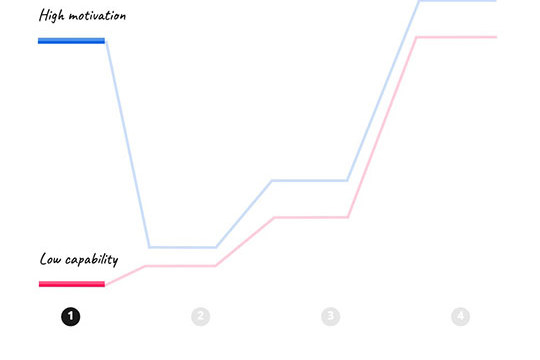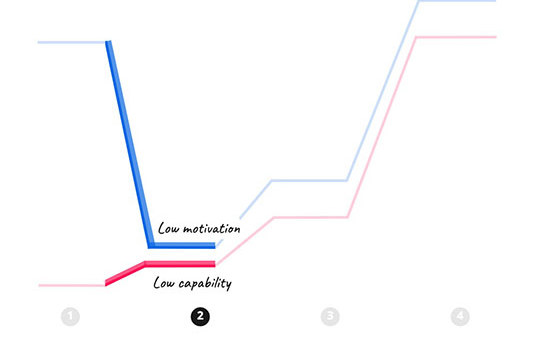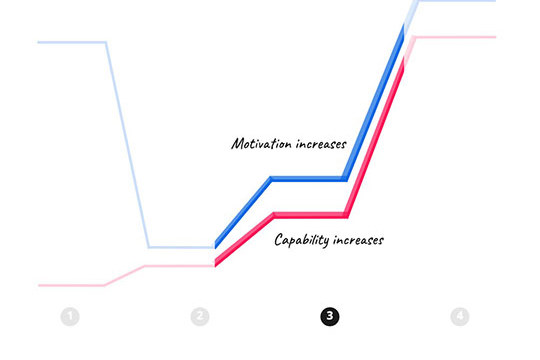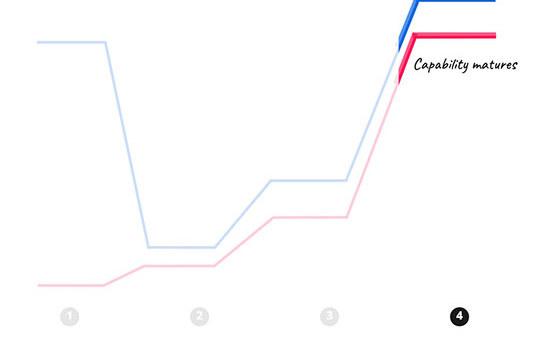
MAKE STRATEGIC LEAPS — GET STARTED TODAY
The Change Curve Explained
The 4-step change curve: What to watch out for and how to bring your leadership style along for the ride.
In any new project that requires trying bold, new things, there are bound to be highs and lows. In fact, these highs and lows are so common we can map them to 4 specific phases called the change curve.
Read on to find out:
- The 4 key phases of change for your team
- How to identify the phase your team is in
- How to adapt your leadership style to help teams move through these phases.
The Honeymoon
Welcome to phase one, the Honeymoon. Your project is just beginning. The team’s motivation (and yours!) is sky high. The challenge you are facing is new and exciting. The team has tons of ideas and can’t wait to dive in.
Thankfully the team don’t recognise it just yet, but the skills and knowledge they’ll need to be successful in delivering on their big ideas are at the lowest point they’ll be throughout the entire project. Navigating the project will require developing the new capabilities and understanding to apply an unknown solution to this specific challenge in this context.
Leading during The Honeymoon phase requires a direct, clear, “do ABC'' approach. It’s easy for progress to stall if the team get too caught up in creative problem solving. They need clear, consistent direction to make early progress.
There’s likely to be lots of information and the reality is they're going to forget some stuff in the complexity. That’s okay, just go with it.

The Crash
Here the team begins to grasp what they don’t know. Their competency for the change is still low while the complexity that is beginning to reveal itself is high. Motivation plummets and the team starts wondering: Do I really want to do this? Am I the right person? Can I really achieve what we need to achieve?

Your leadership style is critical during this phase. It's time to put your metaphorical arm around the team’s shoulder explaining that the dip happens for everyone on every new challenge, it's normal. Just talk about it and be upfront about what’s happening. Your coaching skills are more important than ever here.
The team likely feel embarrassed to admit that there are things that you've told them they haven't actually remembered and aspects of the project they don’t know how to tackle. By not asking questions, they don't progress and that employee or team are at risk. The most important predictor of somebody moving through this phase is if they are asking what they might call “stupid questions.”
The Climb
Now the team’s capability starts to build as they understand the nuances of that new challenge and have built up the knowledge, skills and teamwork to begin to tackle it. As a result, motivation starts climbing.
Leading during The Climb means letting go a bit. Give teams the autonomy to run with their newly-found confidence and motivation. You’ll find that creative problem solving back and targeted at the specific challenge and context that matters most.


The Plateau
Congratulations, you’ve made it through the Change Curve. The team’s capability is still growing and motivation is climbing at pace.
Leading at The Plateau means you can throw your team really complex, fuzzy challenges and you know, they have the competence, confidence, capability, and motivation to run with them.
When the next big bold project inevitably comes along, you get to remind the team that the change curve happens to everybody. What's important is asking the questions we need to get unstuck.
CHANGE BY SPRINT VALLEY
Change stuck?
Fast-track ambitious ideas and build a future-ready business your people are proud to be a part of.
